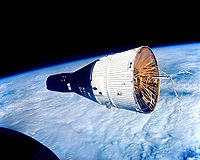
Earth orbit rendezvous (EOR) is a method for conducting round trip human flights to the Moon, involving the use of space rendezvous to assemble, and possibly fuel, components of a translunar vehicle in low Earth orbit.[1] It was considered as an alternative to direct ascent but ultimately rejected in favor of lunar orbit rendezvous (LOR) for NASA's Apollo program of the 1960s and 1970s,[2] mainly because LOR does not require a spacecraft big enough to both make the return trip from Earth orbit to splash down in the ocean, and a soft landing on the lunar surface.[3] The two main proposed methodologies were: the in-space assembly of fueled spacecraft modules via docking techniques; and the in-space refueling of fully assembled spacecraft.[4] This was the preferred approach adopted by the Soviet Union for achieving human lunar missions.[5]
Three decades later, it was planned to be used for Project Constellation, until that program's cancellation in October 2010.[6]
- ^ "LOW EARTH ORBIT RENDEZVOUS STRATEGY FOR LUNAR MISSIONS" http://www.informs-sim.org/wsc06papers/158.pdf
- ^ Launius, Roger D. (2019-06-25). Reaching for the Moon: A Short History of the Space Race. Yale University Press. doi:10.2307/j.ctvhrcxzx. ISBN 978-0-300-24516-5. JSTOR j.ctvhrcxzx.
- ^ "Lunar Orbit Rendezvous and the Apollo Program" http://www.nasa.gov/centers/langley/news/factsheets/Rendezvous.html Archived 2013-04-06 at the Wayback Machine
- ^ Holmes, Brainerd (October 1962). "Manned Space Flight". AIBS Bulletin. 12 (5). Oxford University Press: 56–9. doi:10.2307/1293010. JSTOR 1293010.
- ^ Simons, Howard (March 28, 1965). "Historic Flight Prove Moon Race Is On". The Miami Herald.
- ^ Connolly, John F. (October 2006). "Constellation Program Overview" http://www.nasa.gov/pdf/163092main_constellation_program_overview.pdf Archived 2007-07-10 at the Wayback Machine